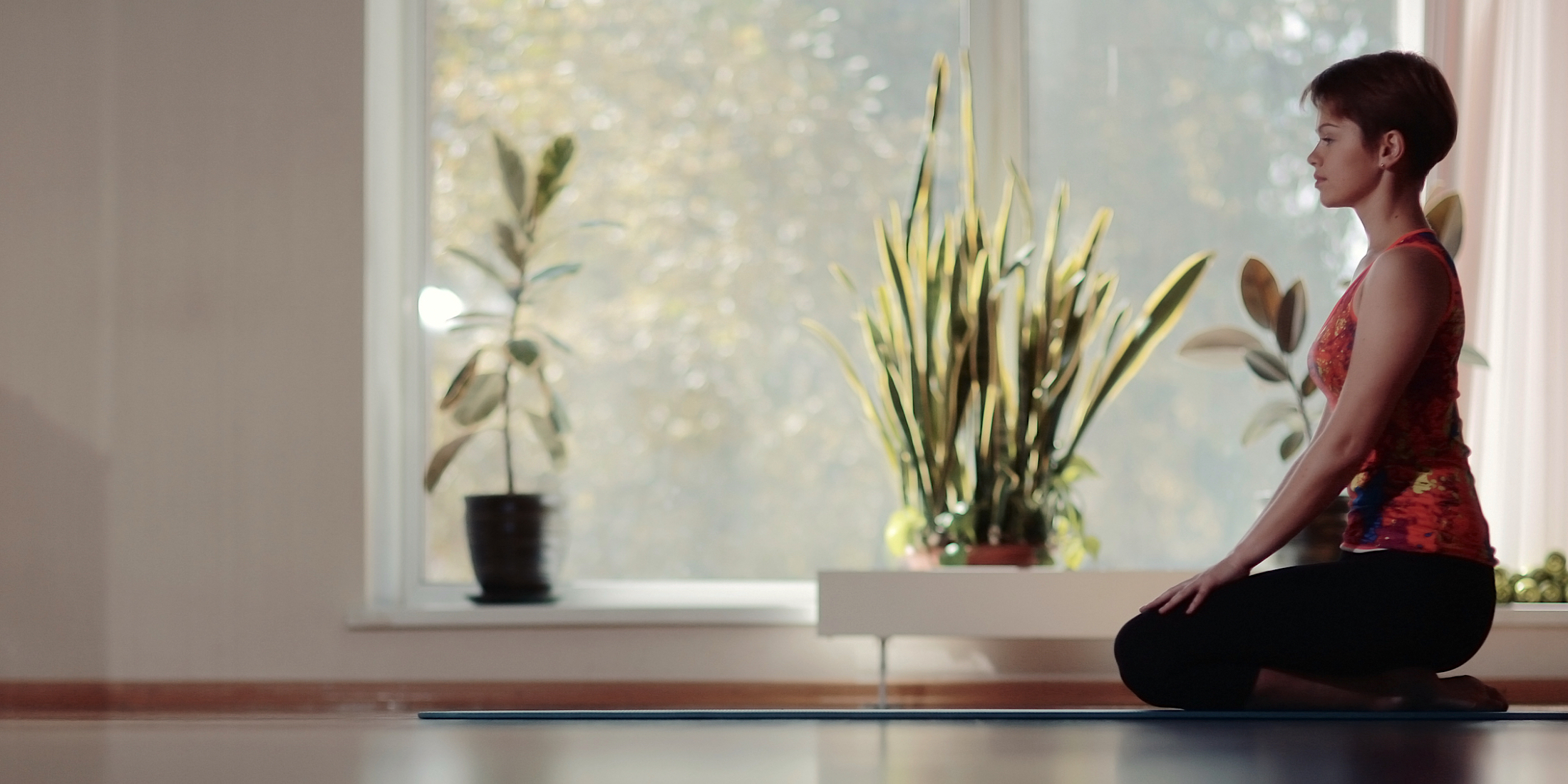This article serves as a precursor to the live trauma-informed yoga sessions that I will be offering on Insight Yoga, specifically helping individuals recovering from past trauma to feel safe and comfortable in their skin again.
Megan Kirk Chang also published this trauma-informed yoga beginner’s guide as a talk on Insight Timer. If you wish, you can listen to it below:


- Trauma-Informed Yoga 101 Megan Kirk Chang, PhD 14:31
How Trauma Impacts Our Bodies
The impact of trauma imprints on every single fiber of our being physically, emotionally, mentally, and socially. I think it’s safe to say that the entire mind body system is impacted and long after a traumatic event has occurred, particular symptoms like flashbacks and memories may show up and lead to a physical response in the body such as muscular tension, constriction, and stress. When we understand the trauma response in the body, we start to realize that trauma is not predominantly psychological, but lives in the cells, the tissues, the muscles, the entire physical system in our body.
One of my favorite authors on the subject of trauma and its impact on the brain and body is psychiatrist Dr Bessel van der Kolk. In his book The Body Keeps the Score, he says that trauma leaves a person feeling chronically unsafe in their own body, even long after the traumatic event has occurred.
Typically, what we know about treating trauma really relies heavily on psychological therapies, such as cognitive behavioral therapy or cognitive processing therapy, but recently more and more emphasis is being given to body-based somatic therapies, such as eye movement, desensitization and reprocessing, mindfulness practices, and trauma-informed yoga. Research has shown that these types of modalities are equally as necessary to treating trauma as traditional talk therapy.
Because trauma of any kind evokes a predictable neurobiological response in the body that involves our fight, flight, or freeze mechanism, an individual may feel as though they’re oscillating between overwhelmed and numbed out, shut down states, especially days, weeks, months, or even years after the event. Our nervous system becomes dysregulated, and we start to experience our world as increasingly dangerous, putting us in a hyperarousal state, potentially leaning to hypoarousal or dissociation. This can be very confusing for individuals and can lead to a host of challenges with emotional regulation, such as extreme polarized emotions to seemingly neutral events, relationship challenges or even substance misuse to help navigate the ups and downs.
I don’t think it’s a surprise when I say that long-term chronic traumatic stress in the body can lead to a host of many other health conditions. This is why it’s so important for survivors to find ways to safely discharge unresolved traumatic energy from the body in safe and health-promoting ways.
Read more: In another article, Megan explains how trauma-informed workplaces can look like.
How Yoga Can Help To Dissolve Trauma
Trauma-informed yoga is a very helpful tool to help strengthen the mind body connection by helping an individual gain a greater sense of ownership over their body again. Trauma-informed yoga recognizes the far-reaching impact of trauma on a person’s physical, emotional, social, and mental wellbeing. This practice helps promote a feeling of safety, normalization, and validation for traumatized individuals regarding the feelings and bodily sensations that surface for them.
The aim of trauma-informed yoga is to help survivors experience internal sensations in a safe and healing way rather than avoid or numb them. Using a combination of movement and breath within the body, we assist individuals to face or overcome potential triggers, slowly, in a carefully titrated way.
What To Expect From A Trauma-Informed Yoga Class
What To Expect In A In-Person Session
In a typical in-person trauma-informed yoga session, the space is set up with safety and neutrality in mind. What I mean by this is that students generally do not practice with their backs facing the door. The space is well lit and the instructor sets up the experience in a way that allows individuals to feel welcome exactly as they are. The instructor provides non-directive instruction to allow the student to be in full control of their experience, where they have the option to choose which movements they’d like to explore or spend more time in. There’s no expectation that you have to hold or spend time in a movement as long as the instructor is guiding it. You can come out or you can stay in as long as you’d like.
As we know, the experience of trauma robs a person of their own autonomy and choice. And so in a trauma-informed practice, various choices will be available to empower an individual to select what feels best for them. In an in-person session, generally, there’s no hands-on assistance, again, for the reason that this may surface uncomfortable feelings.
What Can You Expect In A Virtual Trauma-Informed Yoga Class?
The experience of a trauma-informed virtual class is very similar to an in-person class. Generally, the movements are of a slower pace than a typical flow style yoga class, and the movements are generally ones that bring a sense of ease and release to the body, not added pressure or pain. Time is spent leaning into, reflecting, and sensing the inner state of the body, something known as interoception.
Yoga And Interoception
Interoception refers to how our body feels on the inside by sensing information about our internal body signals. This combined with both conscious awareness of our feelings and unconscious monitoring of our bodily processes, we can receive, access, and appraise our internal state and ask ourselves, “How do I feel right now?”
When we consciously ask, “How do I feel,” we can take action. We may experience a growling of the stomach, tension in muscles, rapid breath, a racing heart, a dry mouth that may be linked to emotions such as hunger, pain, anxiety, frustration, sadness, or fear. When we tune into the sensations and experiences, we can mindfully sense our inner experience, something that may have been lost if you’ve entered into shutdown or freeze states or dissociation after your traumatic experience.
How To Prepare For A Trauma-Informed Yoga Class
In our virtual sessions, it’s not uncommon for difficult or uncomfortable emotions to arise to the surface. Know that this is normal. As you begin your trauma-informed yoga sessions with me, I want to spend some time offering a few insights to consider before you start your practice.
- You are welcome here exactly as you are. There is no requirement that you need to be in a good mood or that you need to do the entire practice or even know how to do yoga in order to participate. Sometimes the most healing experiences happen when we make it to our mat feeling unsettled. How you are in this moment is enough and welcome. And sometimes, two minutes is all we can do in that moment. And let that be enough for you.
- Wear loose or comfortable clothing that you do not feel restricted in. It may be helpful for you to try on a few pieces of clothing before the practice and move around in them before you make it to your yoga mat. Working towards your optimal level of comfort is key.
- If you’d like, you may wish to have a few options beside your mat in the case that difficult sensations or emotions arise, although this is not necessary or mandatory. Some of the items you may wish to add include a weighted blanket, a pillow, a pair of socks, or a towel, a journal to jot down any discoveries, a bottle of water, and Kleenex. And you can add to this as you’re comfortable.
- If you’re feeling particularly tense, triggered, or stressed, you may wish to incorporate the five senses into your practice. Perhaps you may wish to open a window to allow the cool air to come in. Maybe you want to spray your favorite essential oil or drop a few drops on your hands and breathe deeply in before you start. Or you might like to have some flavored water or a cup of tea that you can turn to in the middle of your practice. When we engage our five senses, we bring ourselves a sense of grounding into the present moment. And we must remember that it’s neurologically impossible for the brain to hold a worry or a fear while at the same time being in the present moment. So bring in, add in the five senses to your practice.
- Spend some time prior to starting the session to make a plan for yourself to navigate any difficult triggers that may surface in the session. We can’t always predict when this might arise, so it’s very important that you spend some time figuring out what might be helpful for you if a trigger surfaces. For example, it may be helpful to identify in the body an area of safety or neutrality that you can return to. Perhaps you want to place gentle contact of your hands over your heart or move into a lying down position. You may even want to practice close to a wall so that if a trigger happens, you can lean against the wall and feel the support of the wall behind your back. Sometimes, having a spray bottle with water or essential oils to mist yourself in the midst of a trigger is also helpful. And, also practicing any deep belly breathing technique that you know and love to help bring yourself back to the present moment into the here and now.
Gently Learning To Face And Navigate Triggers Through Yoga
In many therapeutic practices, there is a strong urge to avoid triggers and prevent people from getting to a state of overwhelm. What I want to say in trauma-informed yoga is that I invite you to consider leaning into the wisdom of being able to face your trigger if only for one breath more than before. If you want to stop participating and return to another activity, you feel free to do what makes you the most comfortable. Everyone will be at different stages and levels of comfort when it comes to navigating triggers, and it’s important to remember, as best you can, that triggers are your ally and can help point to an area where you’re not currently free. Allowing the trigger to unfold in a safe way by trusting you can sit with the emotions and bodily sensations that are surfacing takes time or practice.
Read more: Discover more ways to identify emotional triggers.
As you navigate your trauma-informed yoga class, sometimes it means taking one more breath than before. Sometimes that means simply listening to the practice rather than engaging in the movement and just hearing the words. And sometimes that means letting the tears flow exactly as they are coming. If you find in this practice that something is too overwhelming, I trust that you know how to reach out for professional support and guidance by a trained and qualified psychotherapist or medical professional.
I look forward so much to welcoming you to my yoga sessions and guiding you and assisting you on your healing journey. I am grateful for your time here, and I hope this helps set you up for success as we start to practice together.
Discover all virtual yoga classes – including Megan’s – on Insight Timer here.
Don’t miss exploring Megan’s profound trauma healing meditations on Insight Timer, find her full free collection here.


- Trauma Healing - Emotional Triggers Megan Kirk Chang, PhD 15:45
- Trauma Healing - Waves Of Emotion Megan Kirk Chang, PhD 13:30
- Trauma Healing - Grounding With The 5 Senses Megan Kirk Chang, PhD 9:00








